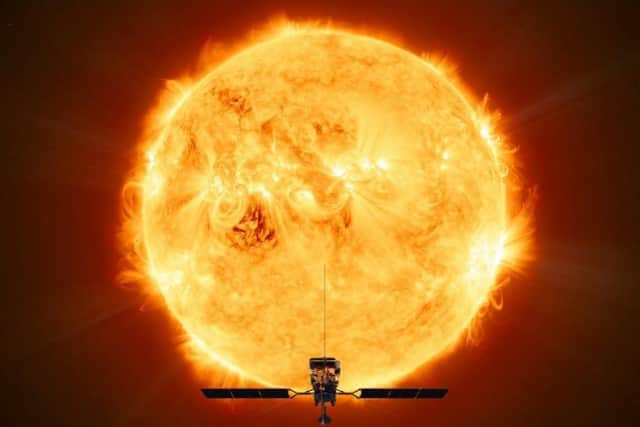'Cannibal' solar flare and space storm means Northern Lights visible from Derry
and live on Freeview channel 276
The space storm - caused by geomagnetic turbulence on the surface of the Sun - means there is a good chance the Northern Lights, or the aurora borealis, can be seen even as far south as Derry city tonight and tomorrow morning.
Speaking to the 'Journal' the Derry-born astrophysicist Dr. Matt Nicholl said: "People are calling this a 'cannibal CME'. It sounds scary but it's harmless!"
Advertisement
Hide AdAdvertisement
Hide AdMatt, a lecturer in Gravitational Wave Astronomy at the University of Birmingham and a Royal Astronomical Society Research Fellow, is from Eglinton originally. He explains how it works.


"A coronal mass ejection happens because the Sun’s magnetic field gets all tangled up by all the motion on its surface. Sometimes it snaps back into a simpler arrangement (called magnetic reconnection) and this releases enough energy to cause an explosion of material out into space.
"It’s quite common, but not always launched in a direction that brings it towards us. Apparently right now there are two CMEs on the way to Earth, and the second one is going to overtake the first one to make one giant CME."
The Foyle College old boy knows what he is talking about.


Advertisement
Hide AdAdvertisement
Hide AdBack in 2017 he was part of a team at the Harvard-Smithsonian Centre for Astrophysics (CfA) in Boston, which identified the nearest ''hypernova' - an explosion of a massive dying star shining 100 times brighter than a normal supernova - to the Earth ever recorded.
So what will the arrival of the cannibal CME mean for Derry and Donegal.
"When the charged particles ejected by the Sun reach us, they follow the Earth's own magnetic field and crash into the upper atmosphere, causing the Northern (and Southern) Lights.


"With all this material arriving at once, the Northern Lights should get much brighter than usual. I think if we get lucky and there’s a very clear night, we might see them from Derry, but usually it’s better to head somewhere darker. The north coast might be a good bet," says Matt.
Advertisement
Hide AdAdvertisement
Hide AdThe Met Office monitors space weather because, as it explains, 'changing environmental conditions in near-Earth space such as magnetic fields, radiation, particles and matter, which have been ejected from the Sun, can interact with the Earth’s upper atmosphere and surrounding magnetic field to produce a variety of effects'.
"Enhancement to the auroral oval is possible at high latitudes during March 31 due to the likely arrival of the March 28, CME. Sightings are possible as far south as southern Scotland and Northern Ireland," is the Met Office's forecast for this evening.
Although the huge solar flare is harmless to humans it does have the potential to disrupt technology.
Advertisement
Hide AdAdvertisement
Hide AdThe Met Office has issued a notification for high energy proton flux of 10 mega electron-volt (MeV) - a million times one EV - from 5.40am to 11pm today as a result of the CME.
The warning is minor, however, with the Met Office stating that the flare will have no biological impact and will not affect satellite operations.
It says that it is unlikely to have an effect on aircraft operations in Ireland or Britain, however, there could be minor impacts on the high-frequency radio of aircraft in the polar regions.
In a forecast issued on Tuesday the Met Office Space Weather Operations Centre (MOSWOC) reported high levels of solar activity over the previous 24 hours after a strong X-ray originating from a sunspot region 2975 in the northwest quadrant of the Sun resulted in a minor radio blackout.
Advertisement
Hide AdAdvertisement
Hide AdThis produced the CME which is due to arrive at Earth today.
According to the MOSWOC: "The next enhancement is expected to come from the March 28 CME(s), which are anticipated to arrive, as a combined CME at Earth on Day 1 (March 31). CME effects are then expected to continue into Day 2 (April 1), before gradually weakening into Day 3 (April 2)."
The space motoring unit has been on guard for signs of more severe (G-rated) geomagnetic events which would be more disruptive to radio communications and technology.
Advertisement
Hide AdAdvertisement
Hide Ad"Quiet to Unsettled conditions initially, before Active to G1-G2/Minor-Moderate storm periods are expected on Day 1 (March 31), with the Chance (30%) of a G3/Strong Storm, and perhaps a Slight Chance (10%) of a G4/Severe Storm.
"Disturbed geomagnetic conditions are expected to continue into Day 2 (April 1), before gradually easing into Day 3 (April 2). However, geomagnetic activity may remain Unsettled to Active Days 3 and 4 (April 2-3) due to a possible fast wind from a coronal hole(s) influence," the MOSWOC stated.
Comment Guidelines
National World encourages reader discussion on our stories. User feedback, insights and back-and-forth exchanges add a rich layer of context to reporting. Please review our Community Guidelines before commenting.
